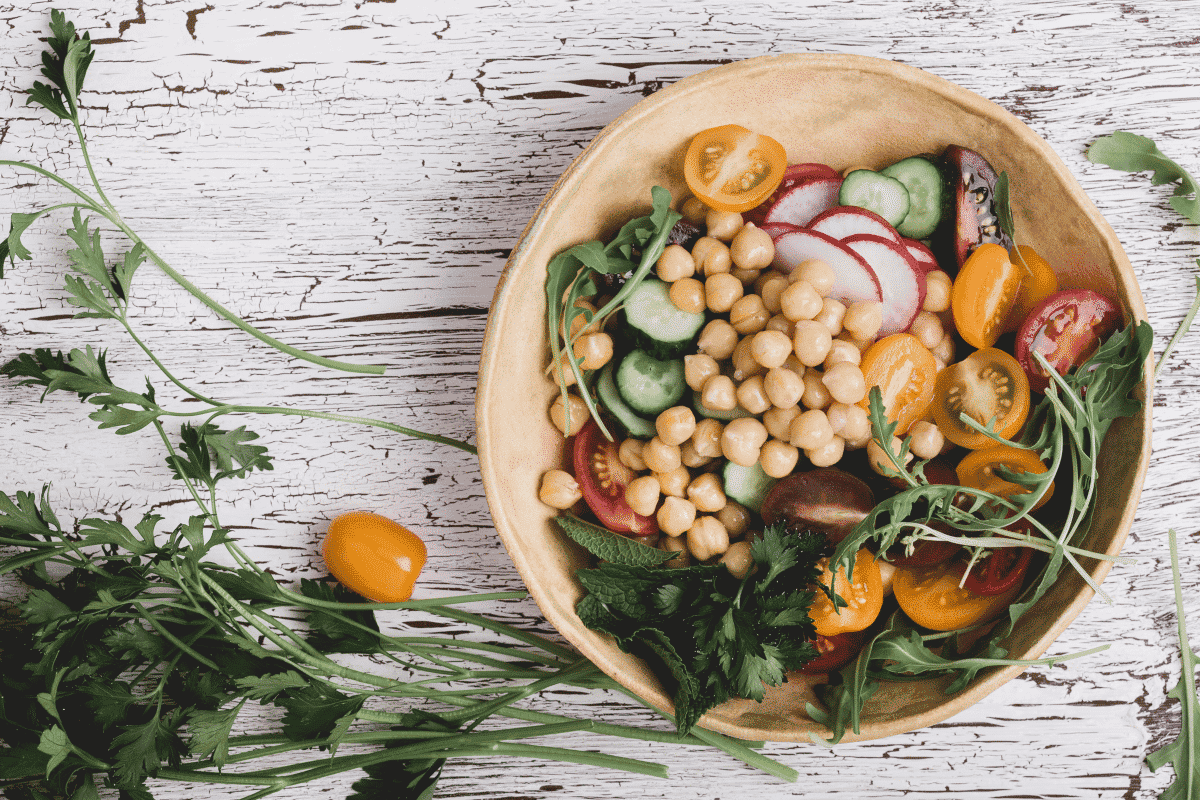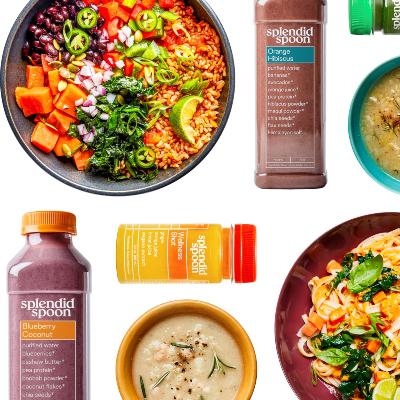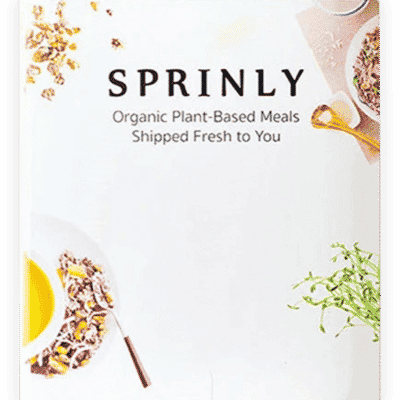

istetiana / Getty Images
Transitioning to a plant-centric diet can help decrease your environmental impact while improving the quality of your diet. These six vegetarian meal delivery services make it easy to enjoy the benefits of a vegetarian diet at home.
Our picks for the best vegetarian meal plan services
Each product featured here has been independently selected. If you make a purchase using the links included, we may earn commission.
- Best Vegan Option – Purple Carrot
- Best Eco-Friendly Option – Splendid Spoon
- Best Organic Option – Sunbasket
- Best Pre-Made Meals – Sprinly
- Best for Healthy Eating – Daily Harvest
- Best for Giving Back – Mosaic
Following a vegetarian or mostly vegetarian dietary pattern is an excellent way to increase your intake of nutrient-dense foods like vegetables, fruits, lentils, nuts, seeds, and beans. However, preparing nutritious plant-based meals can be time consuming and some people don’t have the desire to cook meals every day.
Fortunately, there are a number of meal delivery services that are either entirely plant-based or offer vegetarian-friendly meal and snack options approved by nutritionists in addition to omnivorous choices. Some send you high-quality prepared meals while others make meal prep simple with recipe cards and quality ingredients like black beans, chickpeas, sweet potatoes, zucchini, quinoa, and more included in every box. You can also read our review of the best eco-conscious meal kit services for 2021.
How we chose these vegetarian options
To create our list of the best vegetarian meal kits, we compared each brand on a number of factors. These included:
- Organic ingredients – Are the meal options made with non-GMO organic ingredients and are they free from artificial preservatives and sweeteners? We looked for important eco-friendly labels from authorities like the USDA, Non-GMO Project and the Marine Stewardship Council for any pescatarian plans.
- Dietary restrictions – Do they offer entrees and meals that are gluten-free, dairy-free, nut-free, vegan, paleo, keto, low-calorie, and low-carb?
- Pricing – How much does the service cost in total and how does that break down per meal? Can customers add a la carte items to their plan?
- Packaging – How are the meals packaged? Do they generate a lot of waste or do they use recyclable, compostable, and biodegradable materials?
Based on these categories, here are the 6 best vegetarian meal delivery services.
Purple Carrot

Purple Carrot is a completely vegan meal kit subscription service that offers options for breakfast, lunch, and dinner, plus snacks. Follow simple instructions to prepare flavorful, plant-based meals from scratch and Purple Carrot labels meals that are Gluten-Free, Soy-Free, <600 Calories, Nut-Free, High-Protein, or Quick and Easy meals that take 30 minutes or less to prepare.
Why buy: The Purple Carrot menu changes weekly, and is packed with delicious meals. You can enjoy vegetarian tacos, Thai, or Mediterranean, just to name a few options. Meals generally take between 25 to 40 minutes to prepare and start at .99 per serving. Read our full review here.
Splendid Spoon

Splendid Spoon creates ready-to-eat, vegetarian options including smoothies, noodle bowls, soups, grain bowls, and wellness shots. Splendid Spoon offers five plans, including Breakfast + Lunch and Breakfast, Lunch, Dinner, + Reset. The “Reset” is a one day plan that includes 5 plant-based soups.
Why buy: Customers can choose from more than 50 menu items that are gluten-free and vegan. Splendid Spoon offers a nice mix of comfort foods and healthy meals great for weight loss. Plus, their packaging is almost entirely recyclable. The Breakfast, Lunch, Dinner, + Reset plan starts at 5.
Sunbasket

Sunbasket is a certified organic meal kit delivery service that offers a variety of plant-based menu options, including vegan, vegetarian, and pescatarian. Since it’s a meal kit service, it’s a perfect choice for people who like to cook. In addition to their tasty dinner recipes, Sunbasket offers breakfast, lunch, and snack options.
Why buy: These dietitian-approved vegetarian meals contain no meat and provide between 400 and 800 calories, at least 5 grams of fiber, and at least 10 grams of protein per meal. Sunbasket also makes a good choice for eco-conscious pescatarians because they only use wild-caught or sustainably sourced seafood. Meals start at .99. Read our full Sunbasket review here.
Sprinly

Sprinly is a plant-based meal delivery company that offers vegan-friendly, fully prepared, gluten-free meals that are ready to eat in three minutes or less. Most of the ingredients Sprinly uses are organic and nutrient-dense. Meals provide between 300–650 calories per dish.
Why buy: Sprinly’s packaging includes 100% recycled cardboard boxes, insulation that is compostable, recyclable, and biodegradable, and recyclable plastic containers and ice packs. Meals start at .05 per serving, depending on the plan you choose.
Daily Harvest

If you’re a smoothie lover, you’ve probably heard about Daily Harvest. This plant-based meal delivery service is known for their delish smoothies that come in mouth-watering flavors like Chocolate + Hazelnut and Acai + Cherry, but they offer many other tasty dishes as well. Keep in mind that some of these meals are low calorie and may need to add extra ingredients to make them filling enough.
Why Buy: Choose from over 80 chef-created, gluten-free, plant-based frozen options. Choose a plan and then customize a box with nutritional options like oat bowls, chia bowls, harvest bowls with quinoa, flatbreads, soups, and plant-based lattes. Prices range from .99 to .99 per item.
Mosaic

Mosaic is a smart choice for people leading busy lives. This plant-based meal delivery service provides customers with healthy veggie options for breakfast, lunch, and dinner. Meals are fully prepared and ready to enjoy in five minutes or less. Each meal contains between 5 to 20+ grams of plant-based protein and is made with nutritious ingredients.
Why buy: You can feel good about purchasing Mosaic meals. For every Mosaic box sold, the company works with a non-profit called City Harvest to rescue two pounds of healthy food and distribute it to people in need. The company also uses organic and local ingredients whenever possible. Mosaic has a order minimum. Meals start at .
Why should you eat vegan and vegetarian?
Eating a vegetarian and plant-based diet is both better for your health and the environment. Studies show that vegetarian diets can lead to a lower risk of heart disease, high blood pressure, diabetes, and can increase longevity, according to the Harvard Health Blog.
In terms of the benefits for the planet, a study published in the journal Advances in Nutrition finds that vegan diets produce 50% less greenhouse gas emissions and vegetarian diets produce about 35% less greenhouse gas emissions than diets that include meat. They also significantly reduce the use of natural resources like water and help protect against deforestation associated with pastures.
If you want to introduce more vegetarian or vegan meals into your weekly routine, try one of these six meal delivery services. They are a great place to start making a positive change for your health and the environment.
Jillian Kubala, MS, RD, holds a master’s degree in nutrition from Stony Brook University School of Medicine as well as an undergraduate degree in nutrition science. She is certified in plant-based nutrition through the T. Colin Campbell Center for Nutrition Studies at Cornell University.
- Freshly Meal Delivery Service Review: Better Meals, Less Waste ...
- Home Chef Review: More Sustainable Meal Kits - EcoWatch
- Sunbasket Review: Healthy, Sustainable Meal Delivery
- Purple Carrot Eco-Friendly Plant-Based Meal Kit Review - EcoWatch
- 5 Best (Eco-Friendly) Meal Kit Delivery Services of 2021 - EcoWatch
- Are Meal Kits Better or Worse for the Environment? - EcoWatch
- 10 Best Healthy Vegetarian Snack Ideas Plus The Best Brands

 233k
233k  41k
41k  Subscribe
Subscribe 